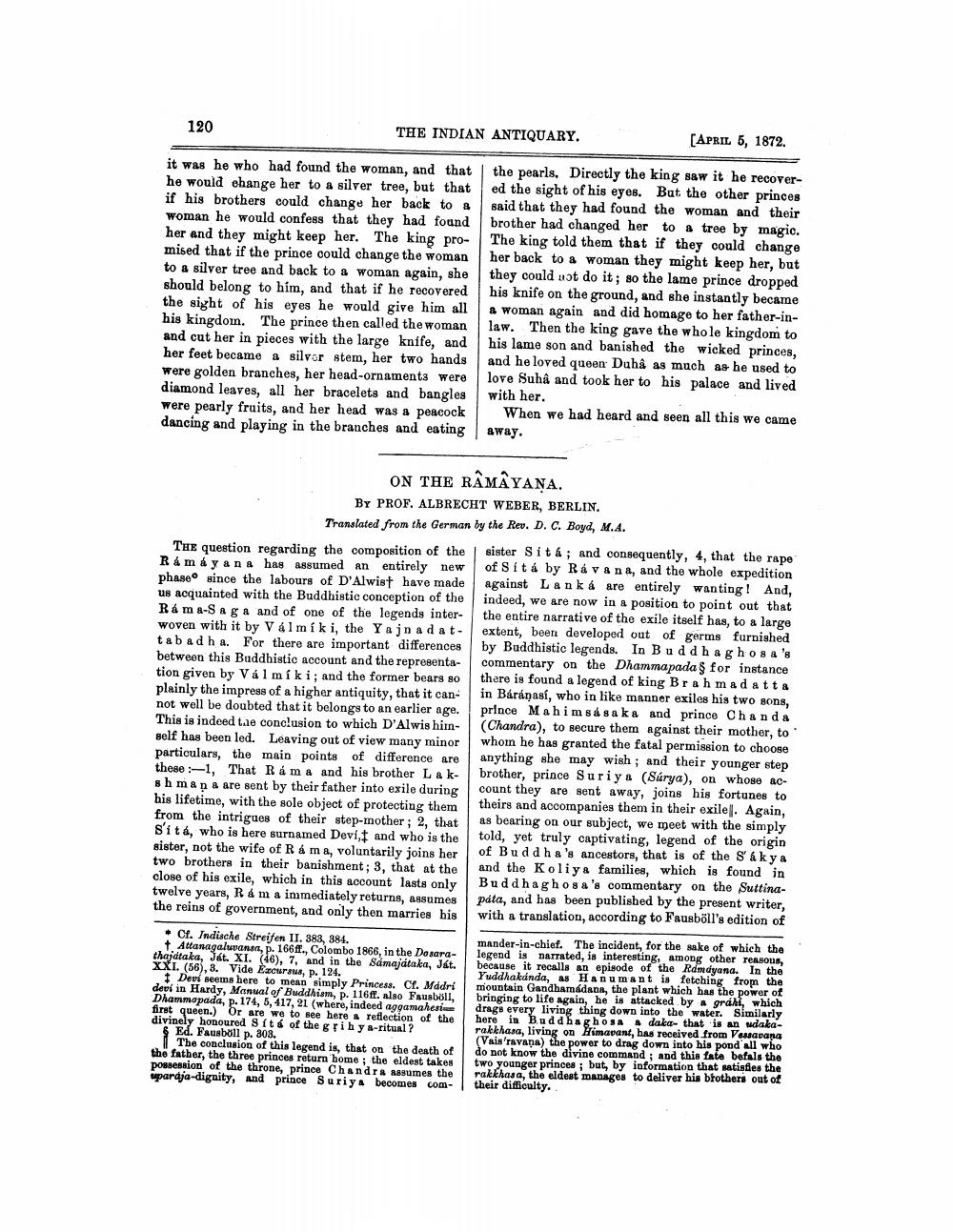________________
120
THE INDIAN ANTIQUARY.
[APRIL 5, 1872.
it was he who had found the woman, and that he would change her to a silver tree, but that if his brothers could change her back to a woman he would confess that they had found her and they might keep her. The king promised that if the prince could change the woman to a silver tree and back to a woman again, she should belong to him, and that if he recovered the sight of his eyes he would give him all his kingdom. The prince then called the woman and cut her in pieces with the large knife, and her feet became a silvor stem, her two hands were golden branches, her head-ornaments were diamond leaves, all her bracelets and bangles were pearly fruits, and her head was a peacock dancing and playing in the branches and eating
the pearls, Directly the king saw it he recovered the sight of his eyes. But the other princes said that they had found the woman and their brother had changed her to a tree by magic. The king told them that if they could change her back to a woman they might keep her, but they could uot do it, so the lame prince dropped his knife on the ground, and she instantly became a woman again and did homage to her father-inlaw. Then the king gave the whole kingdom to his lame son and banished the wicked princes, and he loved queen Duhå as much as he used to love Suha and took her to his palace and lived with her.
When we had heard and seen all this we came away.
ON THE RAMAYANA. BY PROF. ALBRECHT WEBER, BERLIN.
Translated from the German by the Rev. D. C. Boyd, M.A. The question regarding the composition of the sister Sitá; and consequently, 4, that the rape Rám á yana has assumed an entirely new of Sitá by Rá vana, and the whole expedition phaseo since the labours of D'Alwist have made against Lanká are entirely wanting! And, us acquainted with the Buddhistic conception of the indeed, we are now in a position to point out that Rá ma-Saga and of one of the legends inter- the entire narrative of the exile itself has, to a large woven with it by V 4 lmík i, the Yajn adat- extent, been developed out of germs furnished tabadha. For there are important differences by Buddhistic legends. In Buddha ghos a 's between this Buddhistic account and the representa- commentary on the Dhammapadag for instance tion given by Válmíki; and the former bears so there is found a legend of king Brahmadatta plainly the impress of a higher antiquity, that it can in Báránasi, who in like manner exiles his two song, not well be doubted that it belongs to an earlier age. prince Mahim sásaka and prince Chanda This is indeed tae conclusion to which D'Alwis hinn- (Chandra), to secure them against their mother, to self has been led. Leaving out of view many minor whom he has granted the fatal permission to choose particulars, the main points of difference are anything she may wish; and their younger step these :-1, That Ráma and his brother Lak- brother, prince Suriya (Súrya), on whose acshman a are sent by their father into exile during count they are sent away, joins his fortunes to his lifetime, with the sole object of protecting them theirs and accompanies them in their exile. Again, from the intrigues of their step-mother; 2, that as bearing on our subject, we meet with the simply Sitá, who is here surnamed Devit and who is the told, yet truly captivating, legend of the origin sister, not the wife of Ráma, voluntarily joins her of Buddha's ancestors, that is of the Sak ya two brothers in their banishment; 3, that at the and the Koliya families, which is found in close of his exile, which in this account lasts only
Buddhaghosa's commentary on the Suttinatwelve years, Rám a immediately returns, assumes páta, and has been published by the present writer, the reins of government, and only then marries his with a translation, according to Fausboll's edition of
• Cf. Indische Streifen II. 383, 384.
† Atlanagalupans, p. 166ff., Colombo 1866, in the Dosarathajdtaka, Ját. XI. (46), 7, and in the Sámajátaka, Ját. XXL (56), 3. Vide Excursus, p. 124.
1 Devi Beems here to mean simply Princess. Cl. Madri devi in Hardy, Manual of Buddhism, p. 116ff. also Fausböll, Dhammapada, p. 174, 5, 417, 21 (where, indeed aggamahesie first queen.) Or are we to see here a reflection of the divinely honoured sits of the grihy a-ritual?
Ed. Fausboll p. 308.
The conclusion of this legend is, that on the death of thë father, the three princes return home the eldest takes | possession of the throne, prince Chandra assumes the wparaja-dignity, and prince Suriya becomes com-
mander-in-chief. The incident, for the sake of which the legend is narrated, is interesting, among other reasons, because it recalls an episode of the Ramdyana. In the Yuddhakanda, as Hanumant is fetching from the mountain Gandhamádana, the plant which has the power of bringing to life again, he is attacked by a grall, which drags every living thing down into the water. Similarly here in Buddha ghosa dako- that is an adakarakkhasa, living on Himapant, has received from Vanapang (Vais'ravana) the power to drag down into his pond all who do not know the divine command and this tata betals the two younger princes; but, by information that tistes the rakkhasa, the eldest manages to deliver his brothers out of their difficulty.




